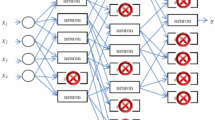Abstract
This paper proposes an improved version of a method for discovering polynomials to fit multivariate data containing numeric and nominal variables. Each polynomial is accompanied with the corresponding nominal condition stating when to apply the polynomial. Such a nominally conditioned polynomial is called a rule. A set of such rules can be regarded as a single numeric function, and such a function can be approximated and learned by three-layer neural networks. The method selects the best from those trained neural networks with different numbers of hidden units by a newly introduced double layer of cross-validation, and restores the final rules from the best. Experiments using two data sets show that the proposed method works well in discovering very succinct and interesting rules even from data containing irrelevant variables and a small amount of noise.
Preview
Unable to display preview. Download preview PDF.
Similar content being viewed by others
References
C. M. Bishop. Neural networks for pattern recognition. Clarendon Press, Oxford, 1995.
B. C. Falkenhainer and R. S. Michalski. Integrating quantitative and qualitative discovery in the abacus system. In Machine Learning: An Artificial Intelligence Approach (Vol. 3), pages 153–190. Morgan Kaufmann, 1990.
P. Langley, H. A. Simon, G. Bradshaw, and J. Zytkow. Scientific discovery: computational explorations of the creative process. MIT Press, 1987.
S. P. Lloyd. Least squares quantization in pcm. IEEE Trans. on Information Theory, IT-28(2):129–137, 1982.
D. G. Luenberger. Linear and nonlinear programming. Addison-Wesley, 1984.
R. Nakano and K. Saito. Computational characteristics of law discovery using neural networks. In Proc. 1st Int. Conference on Discovery Science, LNAI 1532, pages 342–351, 1998.
R. Nakano and K. Saito. Discovery of a set of nominally conditioned polynomials. In Proc. 2nd Int. Conference on Discovery Science, LNAI 1721, pages 287–298, 1999.
R. Nakano and K. Saito. Finding polynomials to fit multivariate data having numeric and nominal variables. In Proc. 4th Int. Symoposium on Intelligent Data Analysis (to appear).
J. R. Quinlan. C4.5: programs for machine learning. Morgan Kaufmann, 1993.
B. D. Ripley. Pattern recognition and neural networks. Cambridge Univ Press, 1996.
K. Saito and P. Langley. Discovering empirical laws of Web dynamics. In Proc. 2002 International Symposium on applications and the Intenet (to appear).
K. Saito, P. Langley, and et al. Computational revision of quantitative scientific models. In Proc. 4th International Conference on Discovery Science (to appear).
K. Saito and R. Nakano. Law discovery using neural networks. In Proc. 15th International Joint Conference on Artificial Intelligence, pages 1078–1083, 1997.
K. Saito and R. Nakano. Partial BFGS update and efficient step-length calculation for three-layer neural networks. Neural Computation, 9(1):239–257, 1997.
K. Saito and R. Nakano. Discovery of a set of nominally conditioned polynomials using neural networks, vector quantizers, and decision trees. In Proc. 3rd Int. Conference on Discovery Science, LNAI 1967, pages 325–329, 2000.
K. Saito and R. Nakano. Discovery of relevant weights by minimizing crossvalidation error. In Proc. PAKDD 2000, LNAI 1805, pages 372–375, 2000.
K. Saito and R. Nakano. Second-order learning algorithm with squared penalty term. Neural Computation, 12(3):709–729, 2000.
K. Saito, N. Ueda, and et al. Law discovery from financial data using neural networks. In Proc. IEEE/IAFE/INFORMS Conference on Computational Intelligence for Financial Engineering, pages 209–212, 2000.
M. Stone. Cross-validatory choice and assessment of statistical predictions (with discussion). Journal of the Royal Statistical Society B, 64:111–147, 1974.
Author information
Authors and Affiliations
Editor information
Editors and Affiliations
Rights and permissions
Copyright information
© 2002 Springer-Verlag Berlin Heidelberg
About this chapter
Cite this chapter
Nakano, R., Saito, K. (2002). Discovering Polynomials to Fit Multivariate Data Having Numeric and Nominal Variables. In: Arikawa, S., Shinohara, A. (eds) Progress in Discovery Science. Lecture Notes in Computer Science(), vol 2281. Springer, Berlin, Heidelberg. https://doi.org/10.1007/3-540-45884-0_36
Download citation
DOI: https://doi.org/10.1007/3-540-45884-0_36
Published:
Publisher Name: Springer, Berlin, Heidelberg
Print ISBN: 978-3-540-43338-5
Online ISBN: 978-3-540-45884-5
eBook Packages: Springer Book Archive




